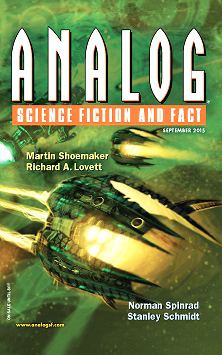 Analog, September 2015
Analog, September 2015
Reviewed by Bob Blough
This issue of Analog has only four stories due to the serialization of a novel. They are a varied bunch, more so than I have come to expect from this magazine.
Maggie Clark contributes “Live from the Air Chair,” a short story that takes place after the world has destroyed itself and humanity is living in small habitats in orbit around the Earth. Whately is a DJ to the habitats, playing old rock to the inhabitants while being a salvager on the side. He goes to unused habitats and salvages all the music and musical instruments he can find. It turns out that something he salvaged in the past is wanted–and very badly–by someone willing to kill to obtain it. It’s a fun idea with interesting characters, including a girlfriend who recently dumped him and an old friend. The McGuffin creates a nice twist at the end. Competent and amusing work.
“Endless Forms Most Beautiful” by Alvaro Zimos-Amaro is my favorite piece in the magazine. It delves into the art world of the future with quantum art known as “Evolutive Art.” The art completely changes and evolves into a “perfect” piece that can take place but once. Greshmann, an art connoisseur and collector, is contemplating his greatest acquisition, which has unfortunately developed an unrepairable leak, when an unwelcome caller visits who claims he can repair the leak if Greshmann will do a necessary task of art evaluation for him. The setting—while not highly described—feels lush and fabulous. Greshmann and his EI (Estate Intelligence) are nicely drawn characters. The story comes to a very satisfying ending.
From veteran SF writer Norman Spinrad comes a just-beyond-tomorrow story about hackers and the Islamic State. “The Crashing of the Cloud” has a very clever idea buried in it—how to destroy the internet when it is not possible to do so (the explanation is in the title) and interesting interaction between an American hacker who hacks for the art of it, and an Islamic hacker who hacks to destroy the Great Satan. But unfortunately it does not gel into a story. It remains talking heads talking to other talking heads. I hope Mr. Spinrad writes a real novel on this premise with strong characters, with his usual incisive wit and deep understanding of global workings.
I am afraid that I must say that the final story is also the weakest. “Racing to Mars” is a by-the-numbers story about a Mars mission. Written by Martin Shoemaker, it concerns a spoiled brat son of the boss who is taught how to be a man on the trip by an irascible captain. It adds nothing to this premise that lifts it above mediocre.